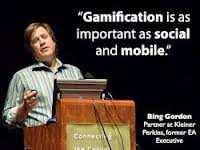Most Sales Vice Presidents are practical people. Experience has taught them to view new, hot strategies with skepticism. Sales VPs need a way to separate real management developments from hype. Maybe you’ve seen the term “Gamification” recently. This article provides an overview of Sales Gamification. Read it to learn if Gamification can help you make the number. Is Sales Gamification just a new term for a sales contest? Or can you use it to focus your team’s attention on your initiatives?
Download the Sales Gamification FAQ Guide here.
In the last few months, two of my colleagues have written about Gamification. John Kenney wrote recently about using it to accelerate onboarding. And Greg Alexander reviewed one of several new books on the subject. This article is more basic and more broad. Top sales leaders see a problem and they ask “How can I fix this?” Sales Gamification helps you focus your team’s attention on the problems that need fixing.
What is Sales Gamification?
- Sales Gamification is a type of sales compensation known as a sales contest. It’s meant to modify the behavior of a sales team.
What does Sales Gamification do?
- Gamifying a sales improvement program helps a sales team set its priorities.
What does it mean to use Sales Gamification?
- Sales Gamification allows a sales leader to acquire and retain the attention of an increasingly distracted sales team.
Steering Your Organization Through Distractions and Noise
Today’s sales professionals are bombarded with information and competing priorities. They are fluent in the use of technology. They toggle between your expectations and requirements, and information arriving via many other platforms. E-mails, CRM updates (Chatter, Yammer, Jive), LinkedIn, Facebook, Flipboard, Twitter…it’s overwhelming. Nothing stays top-of-mind for long. Consider this common scenario:
You bring your team together for product training. For 2 days you teach the new products, and how to sell them. Everyone goes home. For the first two months, reports indicate reps are focusing on the new products. In month three and beyond, however, activity drops like a rock. Why? The sales training is yesterday’s news. Something new has come along. Maybe it’s a new initiative, or comp plan. The team is distracted. A well-designed game can prevent this, and keep attention on the new products.
We typically see our clients consider Sales Gamification for three reasons. First, the most difficult aspect of any new sales initiative is field adoption. We’ve all struggled with this. Second, gamifying a sales initiative improves field execution. Why? Consider how reps share best practices in many organizations today. It’s totally accidental. At the annual sales meeting, top reps run into each other at the bar. They swap war stories (like only sales reps can do). Each learns something. It’s an annual event. Contrast this with gamification, where you can share best practices in real time online.
Finally, sales gamification helps build a culture that values winning. Intrinsic motivation is much more powerful than external stimulus. Carrots and sticks don’t work. But when a sales rep sees his buddies ahead of him on a leaderboard? Or have earned a token he does not have? He motivates himself to do better. This is much more powerful than threats, or a top-down plea for compliance.

How Sales Gamification Works
A Sales Gamification project should have three phases: Strategy, Build, and Play. Let’s briefly look at each one.
Strategy – seven primary activities occur in this phase. You need to choose the right initiative to gamify. It’s also critical to calculate the potential revenue lift. If you determine there’s no revenue benefit, move on to something else. Make certain the game won’t have an adverse impact on your customers. Also, consider the level of disruption improper gamification may cause. Finally, get out in the field. See how the game would be viewed from the rep and manager perspective.
Build – there are three big rocks in this phase. First, baseline the engagement level of the sales force today. Then, forecast what it would be on the initiative you’ve decided to gamify. This is critical. SBI has a formula that can help you. With this done, it’s time to select the type of game. For more information on types of games, download the Sales Gamification FAQ Guide here. Finally, choose the game mechanics that mark the progression to Mastery. This is the goal of all games. When reps become “Masters” at something, adoption and execution issues disappear. There are 5 types of game mechanics (Points, Badges, Levels, Leaderboards, and Rewards). At this point, you have everything you need to design the game.
Play – You’ll need to appoint a “Gamer.” The Gamer owns the game within your company. Drive the game via Feedback, Friends, and Fun. Feedback tells players how they’re doing. Friends refers to the social impact of the game. Fun means making sure the game brings enjoyment. There is nothing worse than a game that no one wants to play. Then, reward the winners. Make it a big deal. Lastly, iterate. Build future games by considering which elements worked or fell short.
Fight the urge to blow this topic off
Many top sales leaders are Baby Boomers. They grew up in an environment where “gamification” meant Monopoly on Saturday night. When a performance issue arises, the tendency is to drive the team harder. In preparation for 2014, take a look at Sales Gamification. Instead of pushing the team, pull them along.
Download the Sales Gamification FAQ Guide here to learn more.



